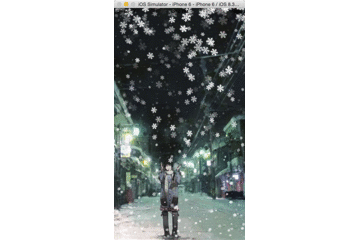жӮЁеҘҪпјҢзҷ»еҪ•еҗҺжүҚиғҪдёӢи®ўеҚ•е“ҰпјҒ
жӮЁеҘҪпјҢзҷ»еҪ•еҗҺжүҚиғҪдёӢи®ўеҚ•е“ҰпјҒ
е°Ҹзј–з»ҷеӨ§е®¶еҲҶдә«дёҖдёӢiOSеҰӮдҪ•е®һзҺ°еӨ§йӣӘзә·йЈһеҠЁз”»пјҢзӣёдҝЎеӨ§йғЁеҲҶдәәйғҪиҝҳдёҚжҖҺд№ҲдәҶи§ЈпјҢеӣ жӯӨеҲҶдә«иҝҷзҜҮж–Үз« з»ҷеӨ§е®¶еҸӮиҖғдёҖдёӢпјҢеёҢжңӣеӨ§е®¶йҳ…иҜ»е®ҢиҝҷзҜҮж–Үз« еҗҺеӨ§жңү收иҺ·пјҢдёӢйқўи®©жҲ‘们дёҖиө·еҺ»дәҶи§ЈдёҖдёӢеҗ§пјҒ
1.з»“жһңеұ•зӨә
зҫҺдёҪзҡ„йӣӘиҠұпјҢеӢҫиө·дәҶеӨҡе°‘зҫҺеҘҪзҡ„еӣһеҝҶгҖӮ

2.еҲ¶дҪңжҖқи·Ҝ
е…¶е®һеҲӣдҪңиҝҷж ·дёҖдёӘеӨ§еӯҰзә·йЈһзҡ„еңәжҷҜжҳҜеҚҒеҲҶз®ҖеҚ•зҡ„пјҢз®ҖеҚ•еҲ°дҪ зңӢдәҶж•ҷзЁӢд№ӢеҗҺжғідёҚдјҡйғҪдёҚиЎҢгҖӮOKпјҢдёӢйқўеӣҪйҷ…жғҜдҫӢпјҢи®Іи§ЈдёҖдёӢжҖқи·Ҝеҗ§гҖӮ
1.еҲӣе»әдёҖдёӘж•°з»„з”ЁжқҘдҝқеӯҳеӨ§йҮҸзҡ„йӣӘиҠұ
_imagesArray = [[NSMutableArray alloc] init];
for (int i = 0; i < 1000; ++ i) {
UIImageView *imageView = [[UIImageView alloc] initWithImage:[UIImage imageNamed:@"snow"]];
float x = IMAGE_WIDTH;
imageView.frame = CGRectMake(IMAGE_X, -30, x, x);
imageView.alpha = IMAGE_ALPHA;
[self.view addSubview:imageView];
[_imagesArray addObject:imageView];
}2.дҪҝз”Ёж—¶й’ҹпјҲCADisplayLinkпјүжқҘжҺ§еҲ¶дёӢйӣӘпјҢдёәд»Җд№ҲдёҚдҪҝз”ЁNSTimerе‘ўгҖӮе…¶е®һжҳҜеҸҜд»Ҙзҡ„пјҢеҸӘжҳҜпјҲCADisplayLinkпјүеҲ·её§жӣҙеҝ«дёҖдәӣгҖӮ
//еҲӣе»әж—¶й’ҹпјҢ并且添еҠ еҲ°дё»еҫӘзҺҜдёӯ CADisplayLink *link = [CADisplayLink displayLinkWithTarget:self selector:@selector(makeSnow)]; [link addToRunLoop:[NSRunLoop mainRunLoop] forMode:NSDefaultRunLoopMode];
3.дёӢйӣӘпјҢе°ұжҳҜжҠҠж•°з»„еҪ“еҒҡйҳҹеҲ—жқҘдҪҝз”ЁгҖӮ
жҜҸж¬Ўд»Һж•°з»„еӨҙйғЁеҸ–еҮәдёҖдёӘйӣӘиҠұ并且еҲ йҷӨе…¶еңЁж•°з»„дёӯзҡ„еҚ дҪҚгҖӮ
и®©йӣӘиҠұйЈҳиҗҪпјҢйҖҡиҝҮUIViewеҠЁз”»е®ҢжҲҗframeпјҢtransformзӯүж”№еҸҳгҖӮ
еҪ“еҠЁз”»е®ҢжҲҗд№ӢеҗҺпјҢе°ҶеҸ–еҮәзҡ„йӣӘиҠұеҶҚж¬Ўж”ҫиҝӣж•°з»„зҡ„е°ҫйғЁ
- (void)makeSnow
{
if (_imagesArray.count > 0) {
UIImageView *imageView = _imagesArray[0];
[_imagesArray removeObjectAtIndex:0];
[self snowFall:imageView];
}
}
- (void)snowFall:(UIImageView *)imageView
{
[UIView animateWithDuration:10 animations:^{
imageView.frame = CGRectMake(imageView.frame.origin.x, Main_Screen_Height, imageView.frame.size.width, imageView.frame.size.height);
imageView.transform = CGAffineTransformMakeScale(0.3, 0.3);
imageView.transform = CGAffineTransformRotate(imageView.transform, M_PI);
} completion:^(BOOL finished) {
float x = IMAGE_WIDTH;
imageView.frame = CGRectMake(IMAGE_X, -30, x, x);
[_imagesArray addObject:imageView];
}];
}3.жңүд»Јз Ғжңүзңҹзӣё
#define IMAGE_X arc4random()%(int)Main_Screen_Width
#define IMAGE_ALPHA ((float)(arc4random()%10))/10
#define IMAGE_WIDTH arc4random()%20 + 10
#define PLUS_HEIGHT Main_Screen_Height/25
#define Main_Screen_Height [[UIScreen mainScreen] bounds].size.height
#define Main_Screen_Width [[UIScreen mainScreen] bounds].size.width
#import "ViewController.h"
@interface ViewController ()
@property (nonatomic ,strong) NSMutableArray *imagesArray;
@property (nonatomic , strong) UIImageView *imageView;
@end
@implementation ViewController
- (void)loadView
{
UIImageView *imageView = [[UIImageView alloc]initWithFrame:[UIScreen mainScreen].bounds];
imageView.image = [UIImage imageNamed:@"backgound.jpg"];
imageView.contentMode = UIViewContentModeScaleAspectFill;
self.view = imageView;
}
- (void)viewDidLoad
{
[super viewDidLoad];
_imagesArray = [[NSMutableArray alloc] init];
for (int i = 0; i < 1000; ++ i) {
UIImageView *imageView = [[UIImageView alloc] initWithImage:[UIImage imageNamed:@"snow"]];
float x = IMAGE_WIDTH;
imageView.frame = CGRectMake(IMAGE_X, -30, x, x);
imageView.alpha = IMAGE_ALPHA;
[self.view addSubview:imageView];
[_imagesArray addObject:imageView];
}
//еҲӣе»әж—¶й’ҹпјҢ并且添еҠ еҲ°дё»еҫӘзҺҜдёӯ
CADisplayLink *link = [CADisplayLink displayLinkWithTarget:self selector:@selector(makeSnow)];
[link addToRunLoop:[NSRunLoop mainRunLoop] forMode:NSDefaultRunLoopMode];
}
- (void)makeSnow
{
if (_imagesArray.count > 0) {
UIImageView *imageView = _imagesArray[0];
[_imagesArray removeObjectAtIndex:0];
[self snowFall:imageView];
}
}
- (void)snowFall:(UIImageView *)imageView
{
[UIView animateWithDuration:10 animations:^{
imageView.frame = CGRectMake(imageView.frame.origin.x, Main_Screen_Height, imageView.frame.size.width, imageView.frame.size.height);
imageView.transform = CGAffineTransformMakeScale(0.3, 0.3);
imageView.transform = CGAffineTransformRotate(imageView.transform, M_PI);
} completion:^(BOOL finished) {
float x = IMAGE_WIDTH;
imageView.frame = CGRectMake(IMAGE_X, -30, x, x);
[_imagesArray addObject:imageView];
}];
}д»ҘдёҠжҳҜвҖңiOSеҰӮдҪ•е®һзҺ°еӨ§йӣӘзә·йЈһеҠЁз”»вҖқиҝҷзҜҮж–Үз« зҡ„жүҖжңүеҶ…е®№пјҢж„ҹи°ўеҗ„дҪҚзҡ„йҳ…иҜ»пјҒзӣёдҝЎеӨ§е®¶йғҪжңүдәҶдёҖе®ҡзҡ„дәҶи§ЈпјҢеёҢжңӣеҲҶдә«зҡ„еҶ…е®№еҜ№еӨ§е®¶жңүжүҖеё®еҠ©пјҢеҰӮжһңиҝҳжғіеӯҰд№ жӣҙеӨҡзҹҘиҜҶпјҢж¬ўиҝҺе…іжіЁдәҝйҖҹдә‘иЎҢдёҡиө„и®Ҝйў‘йҒ“пјҒ
е…ҚиҙЈеЈ°жҳҺпјҡжң¬з«ҷеҸ‘еёғзҡ„еҶ…е®№пјҲеӣҫзүҮгҖҒи§Ҷйў‘е’Ңж–Үеӯ—пјүд»ҘеҺҹеҲӣгҖҒиҪ¬иҪҪе’ҢеҲҶдә«дёәдё»пјҢж–Үз« и§ӮзӮ№дёҚд»ЈиЎЁжң¬зҪ‘з«ҷз«ӢеңәпјҢеҰӮжһңж¶үеҸҠдҫөжқғиҜ·иҒ”зі»з«ҷй•ҝйӮ®з®ұпјҡis@yisu.comиҝӣиЎҢдёҫжҠҘпјҢ并жҸҗдҫӣзӣёе…іиҜҒжҚ®пјҢдёҖз»ҸжҹҘе®һпјҢе°Ҷз«ӢеҲ»еҲ йҷӨж¶үе«ҢдҫөжқғеҶ…е®№гҖӮ